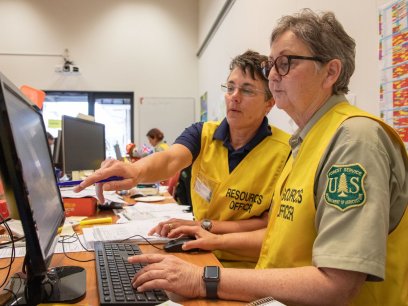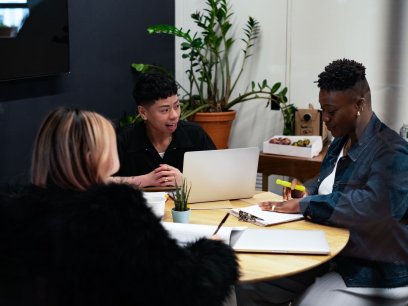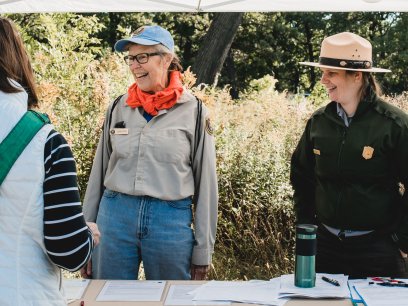
Each year, NEEF awards an average of $675,000 in grants to public land partners and educators across the country. NEEF grantees have led service events dedicated to the restoration, resilience, and conservation of public lands, worked with the National Park Service on professional training and development, coordinated with the US Forest Service on conservation activities, and engaged in place-based environmental education efforts.
The majority of NEEF’s grantmaking is through competitive grant award programs. NEEF grants range in size from $1,000 to $55,000, funding grassroots organizations doing important work to improve the environment and increase diversity in their local communities.
Is your organization new to grant writing? Below, you'll find some suggestions to help ensure that your proposals make it to the top of the stack. Whether you are applying for grant funding from NEEF, or elsewhere, these tips will ensure that your proposal is in top shape.
How to Write an Effective Grant Proposal
Follow directions
Start by reviewing the Request for Proposals (RFP). Are there geographic limits? Does your organization meet eligibility requirements? Does the timing make sense for your organization?
If the funding opportunity seems like a good fit, think about how to frame your ask according to the grantmaker’s priorities. For example, NEEF coordinates with a variety of public and private partners to determine the funding source, goals, and metrics for specific grants.

Be sure to read the RFP carefully and directly respond to all parts of the question. Be clear about who the grant contact is, check your spelling and math, and make sure not to omit contact names or contact information. Pay attention to character limits. Have another staff member review your project budget to make sure line items are accurate.
Pay attention to your partnership letter
The partnership letter is a chance to strengthen your proposal, especially when applying for a grant that, for instance, hinges on nonprofit and public land collaboration.
NEEF encourages applicants to show the passion they have for their work and to demonstrate that they have thought through the project from start to finish.
Fundingforgood.org lists five key messages that every partnership letter should include:
- Commitment to partnership/initiative
- Confirmation of the need for the project
- History of prior successful partnerships or why a new partnership is a great fit
- Commitment to the project as it relates to specific roles, responsibilities, and resources
- Closing assurances and contact information
This is also an important place to highlight inclusivity. NEEF’s grants aim to support a wide range of organizations and communities, and partnership letters can help show how projects expand opportunities in environmental education.
Do your research
Many nonprofits have elevated their digital presence in order to engage existing supporters and reach new audiences, especially during the pandemic. But building a new website or signing onto various social media channels will not necessarily equate to visitors or followers.
Before embarking on any online communications project, do the necessary research. Define your target audience. What are their demographics? Are there any barriers to their engagement with your public land site or organization?
Design an intentional strategy and tell us how you will conduct focused outreach. The grant application is the place to map out your goals and state how you will track your effectiveness in reaching your target audiences.
For more information about creating an online marketing or strategic communications plan, visit:
- The Impact Foundry’s Marketing and Communications Resource Library
- Spitfire’s Smart Chart
- Nonprofit Tech for Good
Align your budget and project narrative
Make sure that the project budget is a direct translation of the narrative in fiscal terms. Additionally, if the grant would only partially support the project, show where the rest of the funding will come from. It is especially important to include matching funds as well as other funding sources (foundation, governmental, corporate or otherwise).
Grant reviewers are likely considering the project’s sustainability, and demonstrating buy-in from other funders will only strengthen the application. This additional funding shows that the project will likely continue to be funded even after the grant period ends.
Here is an example of a budget template used in NEEF’s application process. However, you are welcome to use whatever budget style suits your needs.
Define success
Make sure that the project budget is a direct translation of the narrative in fiscal terms. Additionally, if the grant would only partially support the project, show where the rest of the funding will come from. It is especially important to include matching funds as well as other funding sources (foundation, governmental, corporate, or otherwise). Grant reviewers are likely considering the project’s sustainability, and demonstrating buy-in from other funders will only strengthen the application. This additional funding shows that the project will likely continue to be funded even after the grant period ends.
For NEEF, success simply means that an organization did what they said they were going to do, with the budget they said they would use.
First, determine the end goal of your project and how you will measure the degree of its success. Grant reviewers are looking for your intent, but also numbers and metrics that go along with it.
Any project proposal—whether it be capacity building, programmatic, event, or otherwise— should be accompanied by two types of performance measures:
- Outputs: A type of measure that tabulates, calculates, or records the actual products or services delivered by a program, such as students receiving tutoring or houses built.
- Example: A new donor system will be implemented and X staff will be trained on how to use it via Y training program.
- Outcome: A type of measure that indicates progress toward achieving the intended result of a program, which usually represents a change in the situation of beneficiaries of service, such as educational achievement or housing.
- Example: The new donor system will eliminate redundancies by showing an X% decrease in staff time spent on data entry. Weekly timesheets, pre and post donor system implementation, will track staff use of time.
For more information about nonprofit evaluation and measurement, visit the Management Library’s Evaluation & Outcomes Resource Library.
Tell a clear financial story
One of the most common weaknesses seen in grant applications is that the applicant does not present a clear financial story. Before applying for a grant (of any size), be prepared to submit crucial financial documents.
For NEEF grants, this is of particular importance. All applicants are required to submit the following financial documents to complete their application:
- Annual Organizational Budget (for current fiscal year)
- Project budget (if applicable), Audit for the last complete fiscal year (if available), or Balance Sheet & Statement of Income for the last completed fiscal year
Strong, concise financial information signifies that an organization’s accounting processes are efficient and transparent. Essentially, it tells a grant reviewer that the applicant will be able to manage a grant effectively.
Another helpful resource is the Wallace Foundation’s Knowledge Center for nonprofit financial management.
Because many NEEF grantees are mostly volunteer-run, the organization understands that maintaining financial information can be a big undertaking. Applicants are encouraged to use available resources to help build financial capacity and put themselves in a strong position for grant success.
How to Learn More About NEEF Grant Opportunities
Access past NEEF grantee success stories and nonprofit resources at neefusa.org/grants.
Scroll to the bottom of NEEF’s Grant page and sign up to receive "Grant Notifications" for the latest news and updates. Grants open and close throughout the year. Typically, the call for applications for NEEF grants is open for about four weeks.


